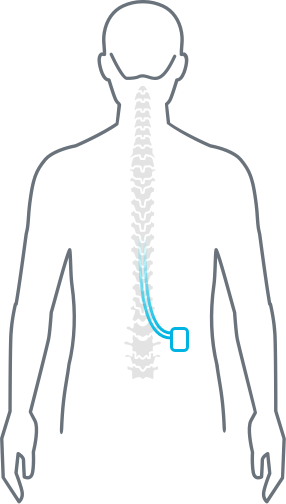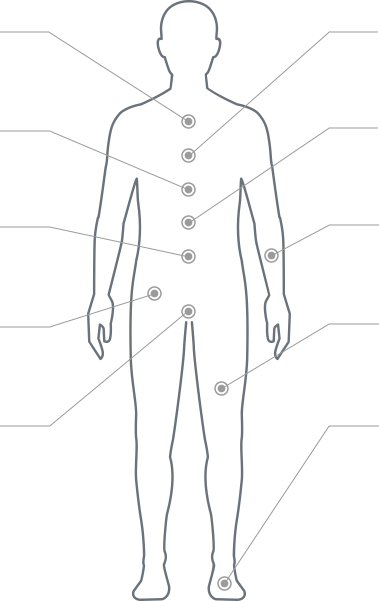Painful back or legs?
You’re not alone. Around 3.24 million Australians experience chronic pain and for around 1.8 million of them, pain restricts the activities they are able to do.1
What is chronic pain?
Chronic (long-term) pain is common. When pain lasts beyond normal healing time after injury or illness (for more than 3 to 6 months), it is considered chronic.1
The different types of chronic pain
Not all chronic pain is the same. People can have a mix of both mechanical and nerve pain.
Chronic mechanical pain
This type of pain is generally caused by damage to the bones, ligaments, tendons, or muscles. Treatment for mechanical pain may involve treating the source of pain, and the options vary depending on location.
Chronic nerve pain
Nerve pain is the result of damaged or malfunctioning nerve fibers sending false pain messages to the brain. With nerve pain, it is generally harder to identify the source. It may come from illness, injury, or no identifiable source at all. This is why it can be so difficult to manage.
To learn more about common forms of pain see resources from pain australia.
Managing chronic pain
Treating chronic pain can be a long, frustrating journey.
The goal is to find a treatment tailored towards an individual’s needs. As part of a pain management plan, doctors may prescribe lifestyle, non-medication and supportive therapies, medications, surgery, or injections. However, individual responses to these treatments vary, and each come with different types and risk of side effects. Some options available include:
Physical activity
Psychological therapy
Prescription medications
Surgery
Prescription injections
Spinal Cord Stimulation (SCS)
See a specialist
Seeing a Pain Specialist (a doctor who specialises in pain management) may be helpful to explore the different ways to manage chronic pain because there can be a lot of 'tinkering' to find the right balance between enough pain relief whilst minimising the risk of side effects.
When chronic pain patients undertake a program of care at a pain specialist, they see significant improvements in pain levels and quality of life 2
More than 50 pain management centres across Australia provide interventional pain management options to people with chronic pain. There are three levels of pain services that may benefit you.
Level 1 and 2 facilities will require referral from a GP. To find a pain service near you access the National Pain Services Directory.
- 3 in 4 people report overall improvement following treatment 2
- 51% were able to reduce their opioid use by at least half 2
Introducing Spinal Cord Stimulation (SCS)
As an intervention for chronic pain, spinal cord stimulation (SCS) can be an effective alternative or adjunct treatment to other therapies that have failed to manage pain on their own 3

SCS is a well-established approach to managing chronic pain used globally for over 30 years. More than 250,000 people have received SCS to treat chronic pain worldwide.3
It includes a small, implanted device that safely transmits mild and undetectable electrical pulses to the spinal cord.
The pulses calm the nerves and reduce pain signals to the brain. A Spinal Cord Stimulation is also drug free therapy and is fully reversable procedure .
SCS is indicated for management of chronic, intractable pain of the trunk and/or limbs, including unilateral or bilateral pain. A careful assessment by a multidisciplinary team, and discussion of the patient’s expectations and goals, will help identify appropriate candidates for spinal cord stimulation.3
1.Speak with a healthcare professional offering Spinal Cord Stimulation
Find out if Spinal Cord Stimulation is right for you
Identifying a healthcare professional that offers Spinal Cord Stimulation is an important first step. You will require a referral from your GP to see an Interventional Pain Specialist. At your consultation, your Pain Specialist will assess your condition, discuss relevant treatment options, and answer any questions you may have.
2.Try Spinal Cord Stimulation in a trial
In 1-4 weeks, you can discover if Spinal Cord Simulation is right for you.
The trial system delivers the same therapy as the implanted device. The trial is a minimally invasive procedure, completed under anesthetic is generally a day procedure.
- Thin, flexible wires, called leads, are placed beneath the skin and next to the spine.
- You wear a device under your clothes or on a belt that delivers stimulations to the leads.
- The system is customised for your pain. You then evaluate your pain relief and improvement to your daily activities.
- If you and your healthcare professional agree SCS works for you, then you can move forward with the implant.
3.The implant procedure
A successful trial opens the door to continuing with Spinal Cord Stimulation therapy.
A successful trial opens the door to continuing with Spinal Cord Stimulation therapy.
The implant procedure is a minimally invasive procedure, completed under anesthetic is generally a day procedure. During a minimally invasive procedure, a small device is implanted under the skin, just above the beltline or in the buttocks area. It’s connected to thin, flexible wires, just like those used in the trial, that are placed near the spine.
Post the implant you will receive post procedural follow up with your interventional pain specialist as well as programming appointments with your SCS device representative.
Want to learn more about Nevro or chronic pain management?
Nevro has been available in Australia since 2011 and today have over 3000 people who are using the implanted device to manage their chronic neuropathic pain.
Speak to your doctor to assess if spinal cord stimulation is appropriate for you. You can try a spinal cord stimulator without implant and decide if it's right for you.
To receive more information from Nevro on chronic pain management, how to find a pain specialist or spinal cord stimulation or to find a pain specialist near you take the assessment.
Take our short assessment to find out if Spinal Cord Stimulation is right for you
Take the Assessment
